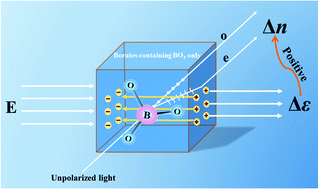Large optical polarizability causing positive effects on the birefringence of planar-triangular BO3 groups in ternary borates†
Abstract
The structure–property relationship of photoelectric functional materials has been recognized as a hot topic. The study of the inner link between the band gaps and birefringence of optical materials is extremely crucial for the design and creation of novel optical devices, but still remains rather unexplored. In this work, taking a series of borates with only planar-triangular BO3 groups, α-/β-TM3(BO3)2 (TM = Zn, Cd), Cd2B2O5, and M3(BO3)2 (M = Hg, Mg, Ca, Sr) as the research subject, the comprehensive relationship between their electronic structures and linear optical properties has been systematically investigated. Through combining experimental measurements and theoretical calculations, the effect of optical polarizability on the birefringence of these borates was clarified. Based on the present discussion, the relationship between the O (2p) bandwidth of the highest valence band and the HSE06 band gaps is opposite. Meanwhile, a method involving the determination of so-called optical permittivity Δε to evaluate the magnitude of birefringence Δn is found to be feasible. A large Δε makes a positive contribution to Δn. In addition, the experimentally measured band gaps and IR vibrations are in good agreement with theoretical results for the compounds α-Cd3(BO3)2 and Cd2B2O5.



 Please wait while we load your content...
Please wait while we load your content...